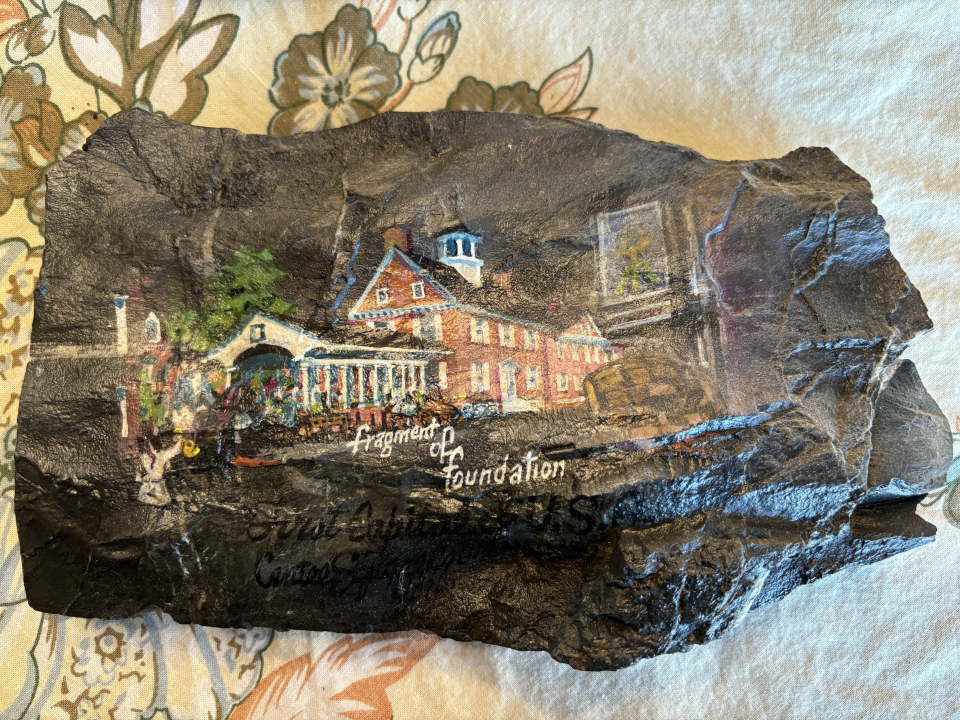York’s piece of the rock: This stone helped support the original county courthouse
Scores of frustrated motorists did not much concern a group of city officials and local historians one fine May day in 1975.
The city rerouted traffic from York’s Continental Square for an archaeological dig to find York County’s most important foundation: an underground structure that, in its low-key way, once helped prop up the county and the United States. Those rocks supported York County’s first courthouse, the place in which the Articles of Confederation, America’s first constitution, was adopted.
The committee planning for the 200th anniversaries of the Declaration of Independence and Articles of Confederation oversaw excavating a 2-foot-deep trench located 22 1/2 feet from the square’s center.
What they found excited them but was hardly a surprise: slabs of limestone that would have supported the two-story brick county courthouse. That measurement, plus other ciphering, showed them that this courthouse that served as the seat of York County for about 85 years after its 1756 completion measured 45-by-45 feet.
They now had what they needed to build a courthouse replica at Pershing Avenue and Market Street in connection with the upcoming 200th anniversaries. In hosting the Continental Congress, the courthouse witnessed that legislative body’s ratification of treaties with France — acts that brought on France as an ally and changed the war.
A newspaper noticed something else. A piece of the foundation was “cadged” by a photographer covering the event. At the time the story appeared, the 3 1/2-pound rock rested in the photographer’s living room until its final destination could be determined. He reportedly considered mounting it on a wooden base as a conversation piece. Or it might make a paperweight that would secure what’s under it against a cyclone.

“Then again, he might use it as a bookend — too bad he doesn’t have a matched pair,” the newspaper reported.
We’ll learn more about what could be called York County’s first rock in a minute, but it’s important to note that today’s Continental Square is getting spruced up, in time for another set of big anniversaries: the 275th anniversary of York County in 2024 and the 250th anniversaries of the Declaration of Independence and Articles of Confederation in 2026 and 2027.
Ribbon cutting ahead
The other day, about 25 members of the Rotary Club of York worked with a landscaper to plant boxwoods, blue star junipers, lavender, veronica and dianthus in the planters on three corners of Continental Square. Cherry trees have replaced the locust trees that were removed.
The planter on the southeast corner will be removed to allow space for events. This landscaping comes in addition to lighting, the stabilization and covering of the underground comfort stations and other improvements that will total about $35,000.
A ribbon cutting is planned as part of Give Local York on May 3.
Continental Square’s makeover likely would have taken place whether or not the anniversaries loomed. It’s been some years since the square has received such a rehab.
This restoration work brings one back to 1925 when Continental Square received its name by authority of the city. Before then, it was known as Centre Square, and it was just that. North/South George and East/West Market streets crossed there. With the 150th anniversaries ahead, Mayor E.S. Hugentugler directed that the newly approved name be painted on streets in all four entrances to the square.
Throughout York County’s long history, anniversaries have been a big deal: in 1927, 1976 and in the window of 2024 to 2028.
City and county officials and the York County History Center have established planning committees for the anniversaries, including the 275th milestone of York County in August. City officials are focusing particularly on the anniversary of the Articles of Confederation, adopted in that 45-by-45-foot courthouse in the center of Continental Square and then sent out to the states for ratification.

The story of the stone
The photographer, with his piece of the foundation in his living room, did at least three things with his prized stone
He asked York artist Bill Koons to paint an image of the York County Courthouse on the stone, with the notation “fragment of foundation.” He encased it in a wooden box with a glass front and mounted the exhibit near the door of his East Market Street home and studio. Those measures might have taken years to enact because he attached an envelope bearing a news story about the excavation to the back of the box and dated it 3/15/90. He noted “please open and read” on the envelope.
There it was for those entering the vintage residence/studio of the cadger in question — Bill Schintz — to pause and take in.
Schintz died in 2018, and his wife, Carol, moved from their longtime home about three years ago, dismounting the boxed rock set and bringing it with her.
She looked for someone to gift it to and believed I would be a worthy recipient. I was a fan and friend of Bill and am glad to have it.
My mounting skills don’t match those of Bill, but I’m determined to pay it forward. So I will bring it with me as I present about anniversaries over the next four years. I will even take it out of Bill’s special box for audience members to hold.
Bill had done such a good job of establishing the stone’s provenance, and we have the newspaper story telling how he served as raider of the lost rock.
Still, I was curious about what York County geologist Jeri Jones would say about my new possession.
Would it support a two-story courthouse?
Sure, he said, if multiple limestone slabs were stacked on top of one another.
Was it a locally quarried rock?
Yes, he said, the rock is found in the Farquhar Park/Prospect Hill/Fireside area just for one example.
“You have yourself a nice piece of Kinzers limestone,” he said.
This county foundational stone has made its way from quarry, to footer, to living room, to conversation piece and now as centerpiece of a traveling exhibit that will tell about the founding of York County and the nation.
Upcoming presentations:
Jim McClure will present about "1960s in York County: How This Tumultuous Decade Shaped Our Communities Today," May 13, OLLI at Penn State York. Also, “Fascinating Things about York Haven at 11 a.m., May 18.
Jim McClure is a retired editor of the York Daily Record and has authored or co-authored nine books on York County history. Reach him at jimmcclure21@outlook.com.
This article originally appeared on York Daily Record: This stone helped support the original York County PA courthouse

